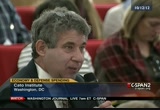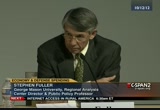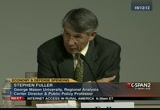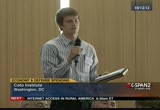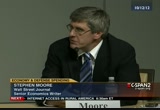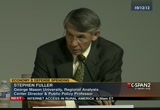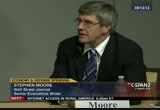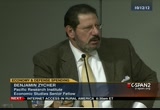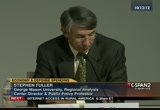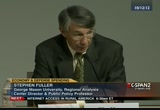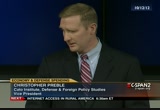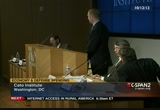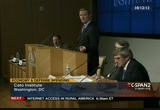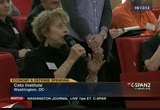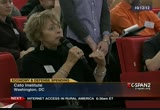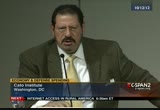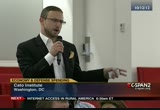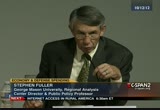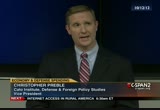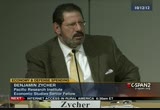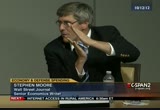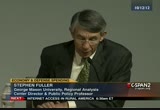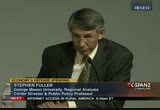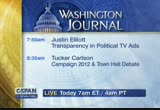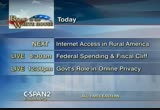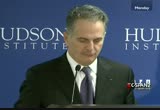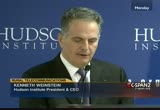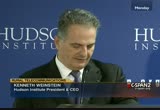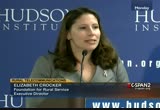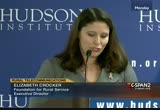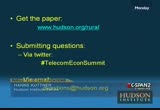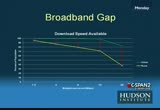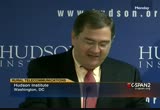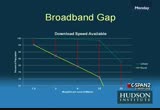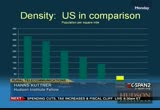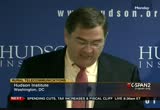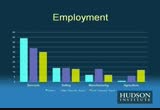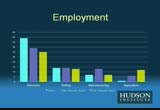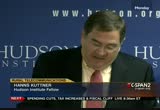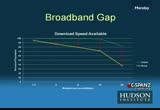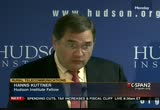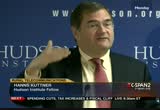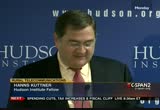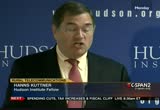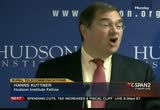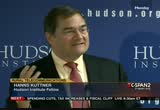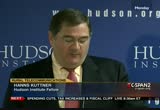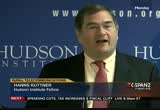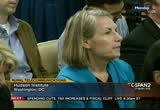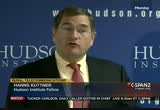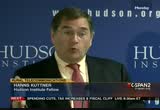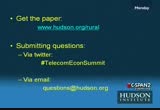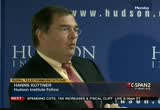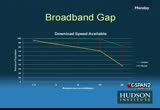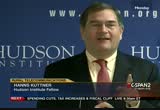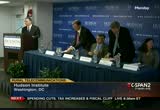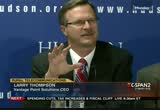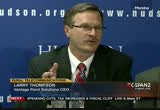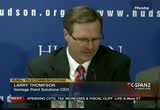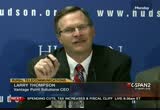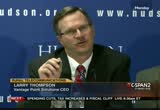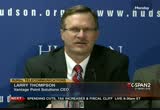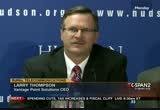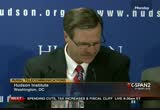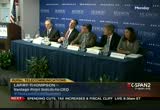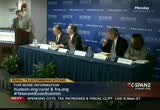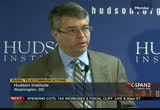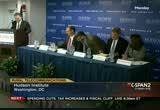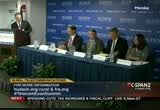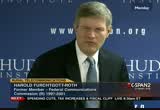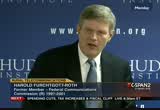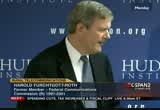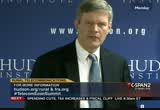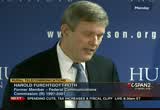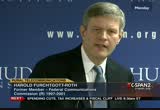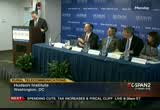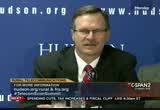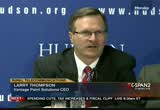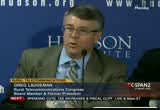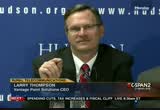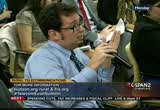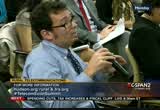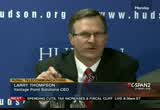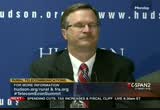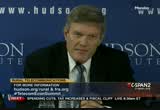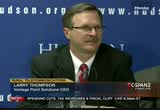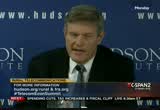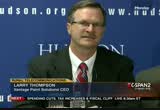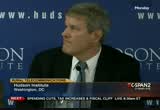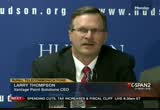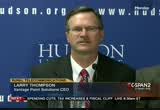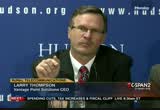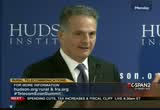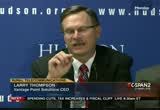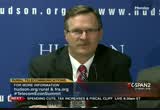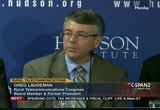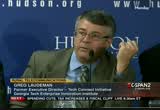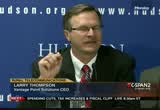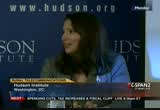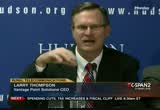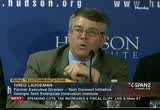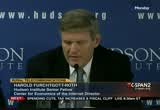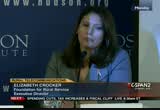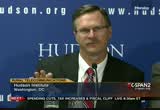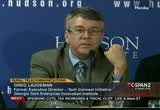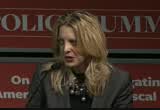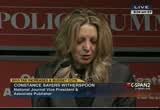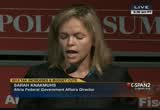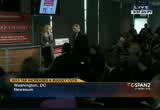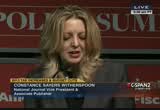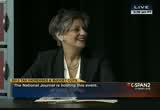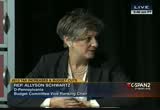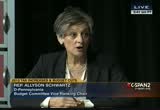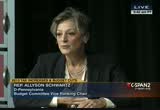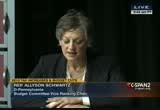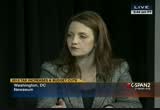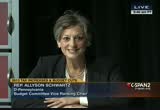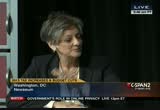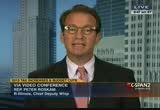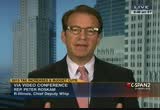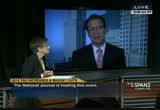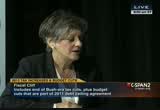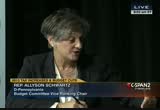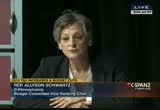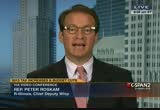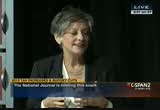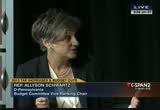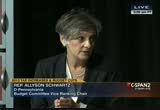tv Today in Washington CSPAN October 16, 2012 6:00am-9:00am EDT
6:59 am
and the notion is that if some of them might be good and get an idea rather than being companies in the paper where it is located, the making two hours from st. louis and move to st. louis and get a job there but enough people have enough commitment that the nature of the family connection to the small town that they are going
7:00 am
to stay there and that is going to give them access to a niche where they can talk about in between the large it company and the offshore thing, rural america is a middle short and the potential for this is constrained by availability of the telecommunications infrastructure in those communities to pull back a business strategy. the health sector, offering convenience for patients. the example of the oklahoma where hospitals are offering radiology services and the second best that they could not have the medicine application driving 54 miles an for even less available services, the hospitals offering the council which is the 2 best to drive
7:01 am
either 60 or 160 miles and health i keep -- urban hospitals demand and 44 hospitals available to them below what you call a structural in the future and call into question the viability and expectations of the ability, at certain speeds and data that is going to be moving around the health care system. to some up, we have it in rural america and because telecom technologies are advancing this gap will grow. it means the national opportunities, the opportunities like goods and services, the
7:02 am
ability to break down barriers and expand the american economy into those areas, and the opportunities for workers to gain skills through growing up education opportunities involving not physical costs -- and missing out on the opportunities for processes -- with that i will conclude and move on to questions and answers before we move on to our panel. we have an opportunity for questions in twitter and also e-mail at hudson.org. i cover and impatient audience sitting on questions. i will wait for the microphone
7:03 am
to get to you. >> pull up the slide of the delta. i am wondering if you have -- how different that slide would be if you took out all of the small towns so it would say a thousand or above. are enough of those -- you included them, separated that out. would that charge change dramatically or not at all? are the small towns actually getting more broadband than this charge implies or not? >> the taxonomy for what is urban and rural in this presentation comes from national
7:04 am
broadband and their taxonomy for urban and rural what you are used to is if you were at the county level, urban county part of a metropolitan area. this approach is to look at urbanized areas where population threshold of those areas is going to be 2500 people or more. if you are in one of those areas could be accounted classified as rural in a metropolitan area but classified as rural but there's a town of 5,000 people in it. for this purpose and purpose of this classification those towns are called urban and if we look at those areas which are rural and the population area is not a
7:05 am
town of 2500. we will stop there so we don't get bloated. other questions? over on this side. >> good morning. thank you to the foundation that the hudson institute. the world's full community trust and president and organizations concerned about organization and move rapidly towards adopting a common core standards across the country and assessments of those standards and by 2014 the assessments across the nation will be delivered online. our concern is rural schools and how to access those. did you look at any trends moving forward. we are two years from that and
7:06 am
we will see if there's any access. >> if you are leaving don't. the technology is focused on that. any other questions from the audience? it could be the case -- >> facing potential technology jumped in rural areas that don't have broadband are able to access -- household get online with a router and 3 gee. is there any potential for broadband projects that won't be necessary because of the technology? >> technology change? that is the next panel -- among
7:07 am
7:08 am
[inaudible conversations] >> thank you, hanss, for that fascinating presentation. the paper is available at www. hudson.org. i'm sure it will be available shortly. we have with us this morning three of the most knowledgeable people in the field of world health indications up here as well. again, with us to discuss this issue in a broader capacity is elizabeth crocker who you met earlier. we will begin first with larry thompson and i will introduce each of the panelists in turn. larry thompson is ceo of vantage point solutions of mitchell,
7:09 am
s.d. company. one of the leading engineering and consulting firms for the rural telecommunications industry. larry is an electrical and computer engineer by training but has more than a quarter-century experience in helping rural telecommunications companies be successful in a rapidly changing technical and regulatory environment. i look forward to hearing from larry. >> thank you, kenneth. just to give you a little bit of a background, we do work and engineering and consulting wireless and wireline, 25% for so small telephone company so we have a lot of experience in the rural area when it comes to broadband. a lot of our business involves giving broadband to rural communities. year-ago, i was in omaha where my parents live and we were
7:10 am
videotaping them to better understand what it was like when they were growing up. we were talking about what it was like before plumbing and phones, electricity. they had to go to an out house. my two daughters were 13 and 14 at the time. they were listening in amazement about what the world was like when their grandparents were growing up. it got me thinking 25 years from now they may be interviewing me and their kids may be listening to my experiences growing up and wondering what is it they are going to find fascinating for or unusual about the way it was when i was young? i have to believe it is going to be things like the fact that we weren't totally connected from a digital perspective growing up. we were connected in my youth
7:11 am
when it came to plumbing and phones and things like that but we were not connected in the sense that they are going to be connected to the global internet with instant access to communication. when i was young we thought having a 20-year-old set of encyclopedias was a great source of information. they will not feel the same way. when i was in college communication was slow. my main source of communicating with my parents was sending a letter. they didn't know what i was doing in college until we court two after the event which sometimes worked to my advantage. the reality is today my grandparents and my daughters can see an almost real-time participation in their lives by the videos and photos, my wife is abating her face book page almost continuously. the way we communicate is
7:12 am
dramatically different and because we are all so immersed in this cultural change we forget how quickly it has happened. facebook was only invented eight years ago and today they say they have got a billion active users. youtube was seven years ago and they have 72 hours video being uploaded to youtube every minute. of every day. six years ago when footer was released i am sure you saw the press release about 10.3 million tweets during the presidential election. a lot of these have shaped how we communicate in our culture and a lot of ways but today to be an effective communicator there are two things that have to be true. it has to be immediate. we can't tolerate the delays we did in the past if and it has to have rich content. photos and videos are becoming
7:13 am
the norm regardless whether between a student or professor or a retailer and purchaser of the product, studio and audience or whoever it might be. what do we mean when we talk about broadband and everybody's definition is a little different. it is always on connection. i have heard all of the politicians and attorneys argue about what should be the minimum broadband standard and things like that. i won't get into that debate but from my perspective as an engineer no matter what threshold used that tomorrow is going to be too slow and if you are going to design your networks around today's standards or even standards in the near term you're going to end up redesigning your network time and time again which may be good from an engineering firm but not good from a public policy perspective. if you think about it, not long ago we fought i s b n was 128 k.
7:14 am
i remember in the dial up modem days and hanss asked to remember those days i would usually assume that for downloading one meg i was that the rule of thumb going to take 20 minutes. recently updated my i had to over 700 mag. i calculated on dialogue that would have taken over ten days to update my i had. through the sampling, the average speed in the u.s. now advertise the is over 27 meg download. that is heavily dominated by urban areas we are talking about the urban and rural divide. it is the problem and the solution. the solution in the sense that it really is what will eliminate
7:15 am
these urban and rural divides and give everybody the opportunity. i lived in los angeles and south dakota. i looked last night from the hotel room at census.gov. the population in 2010 was 6. that is rural pafford. that is a royal. living in both extremes the rural people need more broadband than urban people because they don't have access to the schools or the hospitals or the retailers like the urban people readily access. second, broadband being problem, the problem is not so much from a technology perspective because it is not that hard to engineer these broadband networks. i looked a little while ago at the -- we engineered $1 billion
7:16 am
worth of broadband networks over the last four or five years. engineering them is not that difficult. even implementing them is not that difficult. the difficulty is paying for them. especially in these rural areas it is expensive. you look a lot of these small telephone companies that serve these rural areas although they have been pretty good about deploying fiber into their network they have a lot of copper. that was 30 or 40 years that a lot of these companies had major upgrades, when they went from multi-party lines to single party lines and that is when it occurred. a lot of these loops of long. most of them rely on dsl technologies that have limited distance. copper cable is like the leaky hoses. the farther you go the less broadband speed you can operate those distances. when i was driving to the hotel
7:17 am
looking at washington d.c. some of those apartments i was seeing i am sure housed more people than a lot of our clients have customers. fairly inexpensive to service environments like content to go out for miles to be able to serve some customers. we have a client in rural montana. their exchange was 2200 square miles and the average 0.1 million subscribers per square mile. that is rural. the largest driver of costs is density and we have very low density in the u.s.. what is the solution? if you look back, hanss alluded to this, we had a public policy in 1934 to get voice to every citizen in the united states and we were extremely successful. well over 90% voice penetration in the u.s.. in 1996 the telecom act
7:18 am
reinforced that by even advanced services that everybody in the united states deserve access to these events services regardless of your urban or rural, in 1934 the path was daunting when you look at our vast areas. they had a commitment to be able to do it and today the public commitment has to be comparable. maybe the stakes are even higher in the sense that broadband has the ability to pull people together more than the interstate system did. the solution is relatively simple. we need to change our public policy from focusing on a voice to focusing on broadband and move support from voice to broadband accordingly and levels of support have to be comparable because there is no way that world consumer can afford the cost of that wine. there has to the support mechanism in place just like in the past so if we move to
7:19 am
broadband which clearly is the communication of the future with comparable levels of support, we would be able to see broadband deployed in these rural areas. the opposite is happening. given the fact that support is tied to voice we're seeing a decline in that over the years and recently with the fcc order for the decline has been exacerbated rather than helped. declining voice shouldn't mean declining support. in the next few years unless something changes what we are going to see is probably a shifting to the rural consumers, people that probably can't afford it in the first place but are in the most dire need of it in slowing the world broadband deployment. most of the consumers in that environment wouldn't be able to participate in the new economy and how lot of benefits discussed by hanss would never
7:20 am
be able to participate in the urban and rural divide would be widening. i look forward to your questions. >> thank you. thank you, larry. we have time for questions once we get the panel full the underway. our next speaker i will ask him to speak from the podium is greg laudeman, well known as an analyst and commentator on rural connectivity. the fast president and commentator of the world communications congress and former executive director of the technology cluster initiative at georgia tech enterprise innovation institute. greg has had a long and distinguished career working for major communications like bellsouth and mci and small-business as an entrepreneur with firsthand insights on the nexus between telecommunication and the entrepreneurship and they make economies grow.
7:21 am
>> i would like to say thank you to imus of this and kenneth and hanss for inviting me to come and share my insights after a decade of sojourning around georgia, working with rural leaders to help the understand broadband and telecommunications. is free to share with you because i have a great deal of respect for these folks. when i talk about world telecommunications i don't approach and although i am the technology person from a technology standpoint i approach it from a personal standpoint because folks out there need the technology. they have so much they can do if they understand it. i want to focus on two key issues. one of the learning challenge and there's a lot of work these days on workforce development, the digital literacy, very important but what i saw is often times a lot of the leaders, folks charged with
7:22 am
resources, the ones making decisions about strategy and with all due respect don't understand implications of this technology, how to build it into their business and organizations to be more effected and the other issue that goes along with this, opportunity, is the royal bourbon interchange. this gets missed. in the past we have often seen a lot of situations where a 0 sum game in economic development. i win, you lose. particularly between urban and rural, money flowing through rural areas for economic development or metro areas for economic development and always a struggle. broadband creates a situation that is really important where we have opportunities for complementary connections between urban and rural land knowledge interchange and i will sit on that as i run through my comments real quick. the first thing that is
7:23 am
important to understand is this technology is absolutely essentials. rural areas that do not have that are going to be left -- preserves that come here and totally get away and never have to read an e-mail or they are going to be left out of the economy so it is absolutely essentials. just because you have it doesn't mean miracles happen. number of folks tell me one economic development person in rural georgia said broadband is economic development. no, just because you have the technology doesn't mean you are going to have wonderful things happen. you have to use it. it is not something someone builds for someone else to do something else. you have to think of it in terms of what do you do with it? city council in one community is that we want to have wi-fi in the downtown area. we think we need it. what are you personally going to
7:24 am
do with it and they looked at me and scratch their head and said i don't know. if you can't personally say what you are going to do with it you need to rethink your investment strategy. the other thing that is really important to think about with broadband and this is something we often miss in policy discussions is it doesn't do anything by itself. it is important to have complementary investments in hardware and software and support and training and a number of rural communities there was an importer and lincolnton, georgia, based in england they said we have this system here, international connection connecting to our facilities but we can't find anybody that knows red hot you next so we can't get support so when the system goes down we are paying $160 for someone to drive out in four hours to give us support so there's a huge issue
7:25 am
with complementary investment particularly in human capital. we are tight on time so i want to focus my comments on what i think a policy implications and what we should be doing to address these issues and really the key here are two players trying to sit on the sidelines in this debate, involved somewhat in it but really have to be actively engaged and the first is the technology industry. i am differentiating between telecommunications and technology companies. there are a few important differentiator search and with all due respect for my folks, my colleagues in telecommunications, telecommunications is largely invested in research and development. technology companies are acutely invest and in constant learning
7:26 am
mode. one of the big issues is how to engage local leaders in learning. technology companies have to get engaged in this and the idea is to point out they are all about reaching into mid markets. oral communities are mid markets. you need to engage with local leaders at the roll level to understand what this technology is and how to do it and it is agriculture and service and manufacturing. has got to get into the organization and economically transform the way a operate. the second search of stakeholders that i have a great deal of respect for but been under the gun and that is higher education. i was laid off from georgia tech a month ago because georgia tech's budget was cut and where georgia tech has a huge commitment, getting to rural areas and solve technology problems.
7:27 am
it was not economically feasible but universities, particularly public universities like georgia tech and the land grant universities that have not reached as a mission have a public service commitment to solve these problems and personally i think there's an opportunity for collaboration not only with telecommunications and local leaders but technology companies and universities to get together and really create a learning environment, create community classrooms and laboratories where learning about this technology and gaining competitive advantage from it. maybe a bit of a free-market cure but i believe if we gain that knowledge we will create demand and that will pull the technology into rural areas more efficiently than just pushing it and taking this building and they will come strategy. my comments for this morning. look forward to your questions.
7:28 am
>> thank you. you really set the stage with some good presentations looking into the deeper implications of the broadband gap and what needs to be done to move forward. our next speaker is my colleague harold furchtgott-roth, director of economics and the internet. from 1997 until 2001 harold furchtgott-roth was commissioner of the federal communications commission and served on the joint universal service which was a subject of some discussion earlier in wherry's comments on the need for changing the kinds of subsidies for universal service that are given out. harold is one of the few economists to serve in the federal regulatory commission and the only ones that served on the fcc prior to his appointment to the fcc was chief economist for the house committee on commerce and principal staff
7:29 am
member responsible in part for work on the telecommunications act of 1996. a special pleasure to introduce harold. [inaudible] >> you may need to raise the mike. >> thank you. for a wonderful paper. i learned a lot. i am sure everyone will. it highlights this growing divide between urban and rural america with respect to broadband. can you touch on a lot of implications for specific sectors of the economy. >> you mentioned i found quite intriguing that i also focused
7:30 am
7:31 am
i want to focus my comments in the following area. is the lack or the slow pace of broadband deployment in rural america a result of natural economic consequences? the costs are just too high to support it. or an alternative hypothesis in some instances, not in all, but in some, in fact it could be government action is standing in the way of the natural economic forces that would lead to greater deployment. the description i made of an
7:32 am
economy with enormous natural resources, enormous energy, scarcity of capital and labor, and abundance of land but yet great challenges of distance. if that sounds like rural america, it is. the economic history of the united states over the past five centuries has been very much similar to the economics of rural america today. and what has happened is that the united states has been one of the great success stories of economic development over the past five centuries. it's worked best when individuals and private companies have been able to understand what the prices of the market are, and to react to them. it hasn't worked so well when the government intervenes and regulates the committee or
7:33 am
places taxes that create wedges between the real prices and the prices that consumers and businesses face. we don't have to look any farther to understand this, and to look to 250 years ago to the late 18th century, to the american colonies and what happened between 1767, or 1770, and 1775. a distant government based in london imposed a series of taxes and a series of regulations on commerce in the united states. the purpose of the british government was not to punish the american colonies. it was not to harm rural america. but the unintended consequences of these actions, by distant government on individuals throughout the american colonies was quite profound. and it led eventually to the american revolution. they are are great by great
7:34 am
leaders about self-government, about the proper way to structure and economy. but the catalyst, what ultimately led people to go in that direction, to sever the ties that were very important to them was, in fact, this, this interruption of fundamental economic signals of the market. by a very distant government that had a profound effect on and purely rural economy in the economies. today, the situation is eerily similar. washington creates regulations, whose costs are disproportionately borne in rural america. fuel economy standards are little burden in urban america. they are a substantial burden and rural america were people have to drive great distances.
7:35 am
higher energy costs created by new energy policies for green energy and other purposes are disproportionately felt in rural america. both because energy resources are developed in rural america, they employ rural america, but the higher costs are disproportionately borne in rural america because rural america is proportionately consumes energy. urban america does not. limit the development of private land have little effect in rural america were very few people online. have a profound effect in rural america. health care and educational policies that consolidate decisions about health care and education in washington have a disproportionate effect on rural america. large institutions, large
7:36 am
educational institutions and large health care institutions can more easily deal with washington than can small providers scattered across rural america. simply stated, when the government the roads property and contract rights, when the government decides to make decisions in washington, all americans suffer. but it is paradoxically those americans on the frontier, living in rural america, living in small towns distant from the metropolises, who depend most on the clear and efficient working of property and contract rights, and to suffer the most when those rights are the really. that it is truly no different today than in the past. the disparate effect of regulation on rural areas in america is not necessarily or even likely a conscious policy of the federal government. i'm not suggesting there is a policy to harm rural america
7:37 am
coming out of washington. i think the exact opposite. but the unintended consequences, the unintended consequences of regulation in telecommunications have the precise effect of harming rural america by creating an enormous uncertainty about what prices are creating enormous uncertainty about how to make investments for the future. larry alluded to it in his description of the telecommunications act of 1996. i would encourage everyone to go back and read section 254 and to compare that with what is going on in telecommunications regulation america today. it's impossible to see any hint of our current structure of regulation for rural america if you go look at what the statute
7:38 am
actually says. and what we've also seen in the past years, the fcc regulates for the first time in decades, for the first time in decades exchange access services, house price regulation out of washington. that's not the direction the fcc has headed the past couple of decades with less and less price regulation. much less a price regulation of zero. it's quite astounding. these rules the commission came up with probably no less than the extraordinarily intelligent people running the british government 250 years ago were not intended to create harm. and they were probably widely applauded in london 250 years ago, much as the decisions of the fcc are plotted here in washington, d.c. today. but there are people distant,
7:39 am
rather in rural america today, or in the colonies 250 years ago, who look at these rules, and they scratch their heads and they say, why? why i we doing this? and so i think that's the next step. the next question to be answered from hanns' paper. hanns has described this divide between rural and urban america. how do we cater and how to go forward, what's the next step? and i hope some people will listen to what some people in rural america might have to say to answer that question. indeed, very much. >> thank you, herald, for those characteristically insightful and provoking remarks. our last speaker this morning is elizabeth crocker whom you've met earlier whom is the executor of the founder of rural service. >> herald is a tough act to
7:40 am
follow but i'm going to do what i do best, and i'm going to talk about our people a little bit. even alluded to throughout the morning and i know we don't have a ton of time. i want open up to a lot of questions and discussion with panelists i just want to talk briefly about some more people and some of the struggles they go through and the opportunities that are there i hope we can take advantage of. it's breast cancer awareness month. i don't know if you all realize that with the explosion of think about how but i have my pen a. one of the result went to where it is i talked to three recently in rural america to drive for five hours. i've talked to several who are tried and four at five hours to see a specialist and even then it's not always a specialist because they live in a rural area. so going back to these industry sectors, telemedicine is huge and i believe i said i think it's more important people in rural america for almost anyone because they don't have that immediate access that we would have in an urban area. and honestly coming back to the greater economic picture,
7:41 am
healthier people make healthier communities. that's better for the economy as a whole. that's one area we want to talk about. education, we have a lot of folks from the education sector. talking about distance learning and increasing curriculum and rural communities. frs give the graduate school, that really truly had computers that were from 1985 in their schools. we are talking about, robin mentioned the standard test inhibiting coming up online. how are we going to do that if those schools don't have the same technology, the same capabilities that schools in urban areas, how do they compete? that affects the economy as a whole. same coming into agriculture. again farm bureau service which is here, usda, it's about all those applications that can make our farms in the united states more efficient and more productive. everything from looking at cattle online and being able to buy them to set of remote monitoring system for fields, whatever can make those times
7:42 am
more efficient. better economic outputs for the united states. i have to quote one of my -- senator byron dorgan who said recently america does not move forward by leading people -- leaving people behind. i think that such an up or in point that we need to make with this discussion. we can move forward as a country. we can't be innovative. we can't keep moving forward if you don't have that technology. as larry and i've talked about, it's not just about building the network. it's about growing in and sustained them and working overtime to make sure they are with the need to be because it's a moving target. we have a lot of issues to discuss him want to give all the panelists a chance to get into. let's continue with the panel and hopefully you all can join us an answer, ask some good questions to our group here. [applause] >> thank you, elizabeth.
7:43 am
herald is a tough act to follow, history did a terrific job. let me remind everybody that first you can submit questions via twitter, hash tag telecom summit but, you know, questions at hudson.org as well. let me kick off the discussion with the question. the paper suggests and then we returned to the audience here. the papers just the most likely center for the future of the urban-rural gap is it's going to persist. a key assumption is essentially that most of the projects that are financially viable have already been built. do you think this is a reasonable assumption? what would have to happen to lead to center in which the judicial investment in the urban-rural gap narrows? who wants to take a crack at it? >> i'll start. you know, i would probably even take it one step farther and say, do i need --
7:44 am
>> you're on. >> okay. without some sort of change in our policy, that is not going to stay the same that the urban-rural gap will likely widen. even though the networks that are economically viable may have already been built, the reality is a need to continue to be maintained and upgraded. broadband is emerging -- moving target. the networks have to be upgraded with time, so none of these rural networks that we deal with, other than maybe these small villages, are economically viable. once you get outside of the communities in the rural area, it's difficult if not impossible in most instances to make them economically viable. the only reason they are being built and they are viable is because of the fact that there has been some sorts of ports, and that's a somewhat herald and myself have said earlier.
7:45 am
we have public policy that allows some support the given to these areas so that those rural customers can have more voice, and hopefully in the future can afford broadband. >> unfortunately, i think the answer is yes, that the capital increase, particularly as technology moves forward. my feeling about what's going to make a difference is essentially leadership. hit on just a couple examples, because i think it's where they combined that's important. so take electronic health records, get a lot of work and at every working with rural doctors around us, and often they were like, why am i adopting this, why am i being pushed to do this? is just a pain in the nick. it gets in the way of dealing with my patients. and really the reason isn't -- it's going to help transform health care from a disease oriented modality to a wellness oriented modality. or if we take education as another great example. he has pushed for distance learning has been around for two
7:46 am
decades now, and hanns touched on this in his paper. this makes much more efficient so the kids in rural areas can get access to advanced placement courses. but can you look at things like flipping the classroom, a totally different way of growing education, front page article on the "washington post" this morning about using is teach for one approach, where you can educate 200 kids at the same time, and is highly flexible manner. so the challenge to season-ticket technology out there, it's to rethink the way organizations work. and continued his example, education and health care together, a lot of the learning is not education over here and health care over here. it's having educators and physicians collaboration and learning from each other because moving from a disease oriented modality to a wellness oriented modality and moving from kind of a standardized curriculum to much more custom, open
7:47 am
curriculum, they are very similar changes. and you can look the same thing in public safety. it's been happening in manufacturing. it's been happening in the service sector. and so i think the challenge is a leadership challenge in getting leaders to rethink together but have used technology and use that as a way to drive investment what really needs to occur. >> and i would agree. it's hard look at the future, but you never know. looked in a 15 ago and ask whether there was a gap between urban and rural america, telecommunication service, there really wasn't that much of a gap 15 years ago. one of the differences with broadband also is the symmetry of information flow with telecommunication, with voice. pretty much balance, if you will, with the data. is very concentrated, the flows
7:48 am
tend to go from a few areas, distributed worldwide and a lot of one way traffic and that create unique problems and also opportunities in rural areas. >> just echoing a little bit of what herald said. would've things i think is frustrating for me actually as i see someone for rural telecommunication providers and their being innovative and doing interesting things. a challenge is if they don't have the funding, if they don't have -- that could all change and it could but it doesn't have to. and so i think that it's an interesting thing for us to talk more about maybe with more questions because there's a lot there to discuss in terms of what could be done to make it better. >> let me mention one other thing, that just kind of give you an order of magnitude, when you're instructing the smaller communities, or city, you can oftentimes do that for three to
7:49 am
$5000 per location. sometimes each location might have multiple people living there, but three to $5000. when they get in these rural areas it's not uncommon for them to be 10 to $20,000, and sometimes even more, like that montana area would even be more than that. that i mentioned earlier. but when you look at the economy where you're comparing 3000 or $5000 location to 15 or $20,000 location, it's pretty easy to see us know we can economically do that strictly from and use raven is a little come and that's where the challenge comes is how do you deploy regions like that. >> let me point out to the audience for questions, and -- please identify yourself and state your affiliation if you have one. >> my9 is 10. i'm a reporter. odyssey the fcc as you all know
7:50 am
just last year, almost exactly a year ago, approved what they call comprehensive changes to universal service, after spending months holding stakeholder workshops, going out -- excuse me, nebraska where they had a section out there. you know, supposedly meeting with stakeholders who this is going to affect supposedly, represent rural america, and other folks who live there and are affected by the policies of there. and then they went enemy changes to the system. folks on broadband supposedly going forward, et cetera, et cetera. you know all that. so it sounds like there's a lot of folks up there who are not very satisfied with what was done. haven't really heard though any discussion, concrete pics things except for it's not enough.
7:51 am
i guess i just wanted, to be specific, if if you could be more specific about which you like about the, what needs to be change. i mean i'm know what certain rules carry, have expressed, upset, then upset with some of the reimbursement going forward, and that they will lose and they will not be able to get coming into, to to operate going forward. that's been a handful. i mean, for folks. i just want to hear what your solutions are or what the fcc should have done that they didn't do. >> okay, i'll take a first down at the, and i don't think we have enough time left -- i was at nebraska. i talk to them but some of the issues. there was a lot of issues. i would say one big issue is the fact that we are still locked in our legacy world. now, i'm a big proponent of
7:52 am
change. our system is broken and when you change. there's no doubt about that. i'm not one saying that don't touch the system. it clearly needs change. it just did need that kind of change. the fcc, you know, if you look at it from the small telephone companies, versus the large telephone companies, i'm strictly focus on the smaller rate of return companies, those 1000 or so best serve the rural areas that we're talking about today. but the reality is that the borders still keep them in a voice centric world to earlier i mentioned we need to make the migration to broadband world, and that the support that they received has to be accountable to what they receive historically. neither one of those are true with the orders. the fcc directed us to provide them with the plan, because their plan is going to be worse. we provided them with a plan, it was largely ignored, and you're
7:53 am
right, they did, the stakeholders were involved in the process but i think we largely ignored. [laughter] >> it's hard to know where to begin until once they get started until you know where to into. i think you ought to begin with the statute, and there are remarkably few references to the statute to in the order that came out last year. he mentioned that i talked a lot people. yeah, talked a lot of people. there are a lot of comments in there. and they talked a lot of people not in rural america as well, which is fine. that's exactly what the commission should do. it's very difficult to see the statute in that order.
7:54 am
and then secondly, on intercarrier compensation, this is regulation at its worst. why do we need to go in the direction of price recession? that's the exact opposite direction the commission has been headed in for decades. so i'm mystified by how the commission came up with its result, but it's difficult from the outside looking in. there's a lot of information they have that certainly i don't have, or anyone here has, and a lot of pressures. it's very difficult to understand how the commission needed to come up with an extraordinarily complicated set of rules that has massive answered, and there is certainty, and certainty that the rules of economics, the
7:55 am
pricing models, don't exist. it's, flat out it's a terrible rule or set of rule, pages, hundreds of pages that they came up with. i should have stopped earlier spent i would do so i think there's a huge need for innovation in rural areas because the needs are different. the set of rules that are out there, as harold points out, they are huge barriers to innovation. let me just mention also as far as the order goes, not only did it accelerate that decline in support that i mentioned earlier, so that the amount of the money available, to be able to brought these broadband networks in a rural area is going down, and not at a faster rate. the other thing that i think is almost equally significant is the fact that the order induced
7:56 am
a significant amount of uncertainty in the sense that this regression analysis that have implemented now, you never know if you're going to be getting a cap that's going to the very limit your support or not, and people are afraid to invest just for fear that you're going to hit this cap. once you get that cap, the punishment doesn't fit the crime. the fact that you get cut so severely in your support levels, even if you just go over by a small amount in the regression analysis is unduly complicated, just by changing some exchange boundaries in south the care of -- south dakota, their support changed per couple hundred dollars per couple per year. >> also, the regression analysis changes by a quarter or the year, there's no certainty that whatever the regression analysis the commission is working on
7:57 am
today is what will be in place a year from now or five years from now. look, when telephone countries are happy to hire armies of economist to help them, there's something very wrong when you come up with rules that require you to higher economist to figure out what regression analysis the commission is going to run. and they're going to change e.u. summit. is this the way to run a government? i don't think so. >> [inaudible] >> herald and i could go on all morning on the subject, but one last thing i do want to mention, because of this uncertainty, the loss of support, it's making it extreme he difficult or these companies to go out and secure capital to invest even if they wanted to. now linda, even including our u.s. right now seems to be willing to lend to the small
7:58 am
companies because of the uncertainty that it's introduced into the system, because nobody should they will be able to pay back their loans. >> let me ask if there are further questions. in the back. >> i'd like to ask my questions about -- i'm from the department of agriculture. does it still makes sense to put broadband or increased connectivity out to every house in rural america, or only at a time where we can do the same thing for cheaper by extending 3g or 4g access and allowing folks to set up access and households? >> okay, so the question is would be better in instances to do 3g or 4g wireless rather than, what i was talking earlier, which is putting wired facilities out of all of these locations? there's a right tool for every job, and wireless is not the
7:59 am
right tool to be able to provide big broadband services to homes and businesses. advantage point like i mentioned earlier, we do wired and wireless engineering, and do lots of the. so i met it is to one technology is better than another. i have long said that wireless and wired line technologies are not competitive. they're complementary technologies. they both serve their own purpose. i think it should be obvious when you look at the wireless carriers, the severe caps that they put on capacity limitations. when you're using a wired -- wireless solution to get broadband, they always cap it at two gig or five gig or 10 d., depending on how much you're willing to pay. but the reality is broadband over a wireless network is a scarce commodity. those airwaves you buy from come you get after fcc auctions are
8:00 am
very limited but there's only certain amount of capacity that can go through. it's shared by everybody on that tower, and those towers still require a wireline network to be able to get to the. long-term, people are going to need a wireless device and a wireline access at their home if they want to enjoy the broadband of the future. ..
8:01 am
question. his point is that universal service is not a budget item, and some say urban populations, or people are, as he puts it, tired of supporting rural communities. do you have a sense that rural communities are being targeted now, or is this just a false impression? >> you know, ron brings up a great point. because i think oftentimes you look at these support mechanisms, and people look at it as it's another tax, or it's something that's going to add to the national debt, and that's just not the case. the funding, t a self-funding --
8:02 am
it's a self-funding support within b the telecom industry. right now these rate of return carriers survive on about $3 billion they share per year, about b two billion in high cost support and about a billion when it comes to access which surrounds voice which, as i mentioned earlier, is primarily, essentially going away with time. to put that in perspective, the two large, two largest carriers in the u.s. had cash flow after operations of over $60 billion last year. so we're talking about $3 billion that's self-funded within the industry, um, that go to help support these few rural customers that we've been talking about, um, you know in and luckily, we've got lots and lots of urban customers that can pay a couple pennies more for all of these rural guys that need support, and i think it makes the network much more valuable for everyone.
8:03 am
>> um, i think what ron is referring to is the federal unirersal service -- universal service fund user fee that is attached to telecommunications service, interstate telecommunication services. they'll show up on your wireless bill, they'll show up on your home telephone bill. um, it's a program that has grown substantially. in 1997 when the fund was set up, it was about all told about three, maybe a $4 billion fund. today it's wolfe $8 billion. -- well over $8 billion. the amount that goes to rural telephone companies per se is about $2 billion, so it's about maybe 25%. other programs that are supported by this are, um, low income programs, the schools and libraries program, rural health
8:04 am
care program. they support a lot of programs that have grown substantially faster than the small telephone company support mechanism. today it's not really much bigger than it was 15 years ago. all of the other programs have grown substantially. but i completely agree with that the user fee that we see is, it's too big. this program has grown a lot, and the collection mechanism is broken. it is completely broken. and the commission should have addressed this years ago. and it's, it's amazing that they've come up with yet more complicated rules for distribution, and they refuse to address the collection mechanism. >> further questions from the audience?
8:05 am
let me ask a question. this seems to be two kinds of broadband gaps in this country. one is the rural broadband gap that we've discussed, and the other is the urban broadband gap that's the one that is, i think, traditionally discussed. i think it's gotten more attention in the media over the past few years. you look at robust broadband access, less than 2% of urban residents can't get robust broadband access whereas it seems more than 25% of rural residents don't have access. how do these two gaps differ in the potential that future investment will narrow them? >> well, one thing to keep in mind is, like i said, in an urban environment typically you're served by either fiber or very short copper loops. the short copper loops you can get reasonably high broadband speeds. when you get out of the urban areas, a lot of those are designed at 18,000 feet,
8:06 am
three-and-a-half miles or learn, but you can get about one meg because you know the national standard now, probably about two-and-a-half miles or so of copper. most areas it's how far you can be from your electronics. most areas it's a lot longer than that, and it's very expensive. to push those electronics closer and closer or to the customer, you've got to run fiber, shorten the copper loop and buy all those electronics, more power, more maintenance. so it's going to take money and a fair amount of investment to make that gap smaller. >> we've also talked a lot about population density, but we haven't talked about geographic barriers that telecommunications companies face. some of the challenges actually getting out some of the technology to these homes and no these last mile areas, you know, it can be very challenging from desert areas to mountain areas.
8:07 am
we heard about a bear actually eating through. [laughter] there's things you don't think about that can affect the quality of your service, and, you know, there's a lot of geographic barriers that come into play as well, so something else to think about. >> i think one of the challenges, also, is not so much technological clang, it's the -- challenge, it's the business model challenge. not only did some technologies work better in urban areas than rural areas and vice very -- vice versa, but rural areas are really where you need more cooperation and competition. particularly we've seen some interesting advancements with open source, essentially, business models where rural residents cooperate with one another to build out their own networks. and, again, i think this goes back to, you know, how do we support this level of experimentation when it was a matter of just providing some funds to a telephone company to
8:08 am
subsidize them running more wires, it was one thing. when it comes down to, you know, how do you subsidize rural residents to come up with more efficient and high-impact approaches to building and maintaining their networks, it's a totally different kind of question. >> yeah. back in the '30s when a lot of these farming networks were put together, um, they were running telephone lines on their barbed wire fences to get service. but nowadays it requires fiberoptic cables, for the most part be, to be able to get those kinds of services out. and like elizabeth mentioned, when you put those kind of facilities in, it'll run anywhere from $10,000 a mile to $30,000 or sometimes more per mile just to construct that fiberoptic cable. most of that is just in the labor to move the dirt, you know? or to hang it on the pole. so it's very expensive for a user to be able to, you know, experiment and provide $30,000
8:09 am
per mile. and it varies a hot from geography to geography. sometimes you get into places where there's lava flows, or there's protected weeds or protected salmon in the stream, things like that. all of those strive up the cost, and it is getting more expensive with time. environmental issues and things like that are also getting more difficult with time. >> i just want to point out, you know, because i talked about learning and urban and rural interchange knowledge. there is a huge amount of ingenuity and creativity out in our rural communities, and i think be we don't tap into that to solve this problem, shame on us. if we're just trying to push solutions down from d.c. or anything else, ain't gonna work. we're going to have to engage those rural residents in coming up with better solutions. >> let me ask a question about how fast future broadband's
8:10 am
going to be and what this implies for the urban/rural gap. a decade ago the assessments of broadband's impact looked at the comparisons of dial-up, now we see a majority of americans at least, obviously, in urban communities have access to a service that has five times the capacity. it gets set to some degree by what typical urban users have access to. what can we expect will happen and the definition of what typical service is going to look like on the urban side going forward be, say, a decade from now. >> well, if you look at what's been going on even in the dial-up days, it's been, the increase has been linear on a logarithmic scale. broadband has been increasing between 20-30% per year. the last statistic i saw was 26%. at that rate broadband speeds
8:11 am
double every three to four years. so if you start -- and most be urban areas, like i said, in my small community of 15,000, my basic offering is 25 grand today, but there's reasonable price services from two with different providers in my community that you can get 75-100 meg services from two different providers in my small community. just to kind of show you where -- and i think most urban areas would be comparable. i would say that by 2020 if you don't have 100 meg, you're probably considerably behind. if you look at what google is doing in kansas city, i mean, they're going after one gig. so whatever you think the speed is going to be, i think whatever your guess is, it's probably going to be too low because it increases even faster than a lot of the experts believe it's going to increase. you sit down and say, well, what on earth do can you need 100 meg
8:12 am
for, it's hard to analyze that, but a lot of the stuff that drive the bandwidth haven't even been invented yet. and if you wait especially in these rural communities to deploy your network when the technology is invented or it comes back to you built the bridge, you know, when do you build the bridge, you know, the fact is if you wait until you see the demand, you're too late because most of the time building these networks is a multiyear, often a 10 or 15 or 20-year process for these companies to do because it's so capital intensive. you wait for the application, you're already too late. >> yeah. i think this goes back to the question of wired versus wireless, and and although we definitely see ivo and 4g and etc. squeezing a lot more bandwidth out of our wireless spectrum, in particular in rural areas where you have a lot of white space, there's opportunities for that, but the bottom line is that
8:13 am
fiber is always going to have more capacity and more flexibility as far as cost. you're switching out the electronics to get, you know, additional lambdas out of your fiber. so those places that don't have fiber to the premises are going to be at a disadvantage when it comes to this gap on speed, because the places that have it are going to be able to jump forward faster and faster, where if you're depending on wireless, advanceing band bandwidth is goo be slower. >> let me ask a question that i think is hovering over the discussion to some degree. i think over the past 50 years i think we have seen that potential for various problems to be solved changes because technology adapts, and there's sort of game-changing technologies that no one expects, and, obviously, broadband is an example of how technology has opened up possibilities that no one could
8:14 am
have anticipated two generations ago, even a generation ago. what do you think the real potential is for real technologies to help make up the urban/rural gap, game changing technologies, and how might that affect things, and how might that affect things both at the rural level, also at the top end? and what are the technology issues or constraints that would keep a technology solution from being feasible? >> part of the challenge is that if you don't have the toy toss play with, you -- toys to play with, you can't figure out what to do with them, and that's, i think, part of what we see in urban versus rural on the application side. are there game changing technologies that could come out
8:15 am
of rural areas? you bet, and we've seen a lot of that. a huge amount of innovation has come out of rural areas in the past. but, again, if you don't have the capacity to play with, to experiment and equally if important if you don't have the kind of technological components you need for that, it's going to be slow to emerge, and that's putting the u.s. economy at a disadvantage on the global stage. so i think the urban/metro interchange of knowledge and really creating these rural laboratories and learning environments, incredibly important. >> um, as far as innovations that we can potentially see on thize b that's going to be -- horizon that's going to be a game changer, one thing you have got to realize we're not going to violate any laws of physics in the process. [laughter] the, when i t comes to -- when it comes to wireless, for example, you've got rules like shannon's law that dictates how
8:16 am
much information can flow through any information challenge. right now 4g technologies are getting very, very close to shannon's law, and how much they can get through given this, you know, certain amount of spectrum and a certain amount of power, both of which are dictated by the fcc. the only way you're going to solve that problem is more spectrum or more towers. now, from a land line perspective, there's still a lot of innovation going on when it comes to how much capacity can that fiber really transmit. but the reality is you till need the fiber -- still need the fibroer in the ground. most of these small telephone companies, 65% or more of their total investment is that cable that goes from the central office out to the customer. and to put that cable in the ground, most of the cost is the labor just to get that cable in the ground. so i don't see a lot of technologies that's going to reduce the cost of get it
8:17 am
deploying that fiber, that land line infrastructure because it's so heavily dictated by the labor associated with just getting it this, and the cable itself, you know, is a mature technology, probably not going to be decreasing in cost. we still may see some changes in cost on those electronics and certainly a lot of advances in the capabilities of those electronics that get hung on the side of the house or in the central office. and they're going to get changed out every five or ten years anyway just because of those advances. but the reality is they're a small portion of the overall cost of deploying the network. >> i think it's hard to look out in technological terms more than, more than a few years. i think the current situation was difficult to anticipate ten years ago. if you go back 20 years ago, the commercial internet was just
8:18 am
getting off the ground. technology is, obviously, changing very rapidly. you look at the broad sweep of american economic history, there's some technologies that have, um, been ubiquitously adopted in rural america, and i think this -- in particular the automobile and the truck and other technologies that became very focused on specific locations such as rail and air transportation which could easily bipass large parts of rural america. it's hard to know how telecommunications networks will develop over time and whether there are satellite or wireless solutions that will obviate the need for a lot of feebler- fiber-based solutions. it's hard to see those, but you never know. they may be out there. but certainly not in the foreseeable future. >> i was just thinking if everyone in this room had informed in apple not --
8:19 am
invested in apple not so long ago, we'd all be much wealthier, and that really budget that long ago. really hard to say, but four megabits is not going to be even remotely enough to handle it, and it's, you know, a bare minimum that it's just unacceptable, frankly, and talk about rural communities and what they need to survive at this point, no way that's going to help us through that next step, whatever it may be. >> hanns? >> so in preparing the pape or, one of the thoughts that emerged in the back of my mind which i heard some confirmation on this panel was the frustrating problem of when you have a dual, just a classification the world is either urban or world, and that's only one metric you have. and what we saw in those density graphs was just, you know, a one
8:20 am
little line doesn't capture it. and another area where i've done work, the health care sector. there's the notion -- there's urban, rural and there's frontier. and a lot of this is not so much -- or a big part of the gap and the challenge is less to do with small towns and with, um, even more remote things, things you might call frontier. and if only the data people would be more nuanced in the how they presented thicks, we -- thing, we would have a better understanding of what was going on. so that was sort of the sense that was building up in my mind, and i heard some confirmation in the panel, and maybe you can tell me that i'm right, and then i can sit down. [laughter] >> i would agree. a lot of the costs are driven by the fact that when you get a cluster of homes, if it was 700 people or 800 people, you can construct those with a different economy of scale. and often times when i talk
8:21 am
about urban versus rural on town versus rural, the town is that cluster that's around the central office of that telephone company. the rural guys are the people that live outside. it's the farmers and the people that you have to go a fair amount of distance to get to to serve. but, you're right, hanns, the economics are different. >> going back to the question about innovation, you know, you can just take a few areas that we don't know exactly what the technologies are, but they're coming. big data, robotics, simulations. rural areas you might say, well, where do they fit in these equations? well, if you look at particularly resource utilization, there's huge seas of data that are going to be generated out of rural areas in agriculture and health care and service sectors, um, environmental monitoring. so this is, you know, kind of one set of technologies.
8:22 am
robotics, just make a little humble prediction that in ten years it won't be all that unusual to see a robot trunlding down the -- trundling down the street, and increasingly ha, this ns was talking about tractors, they're essentially robots. and you see this as an increasing use of autonomous and semiautonomous machines. and the point i'm making here is that if you are pulling all of this data out of rural areas and you've got semiautonomous or autonomous devices that are operating out there, does that count as density? you know, you need to pool this data out, you need to send it back. but there might not actually be any people there. and i think that's going to require some rethinking about how we do this too. >> now, hanns, you're exactly right. one way of looking at the differences, you can look at an you are baa area -- urban area, and there's ubiquitous availability of 100 meg,
8:23 am
neighbor a few years one gig data. but in concentrated towns in rural america where there might be a hospital, where there might be be a large educational institution, you might have 100 meg available data there but in a 10 or 20 mile radius around that hospital there may be little or no high-speed broadband available. and that's kind of the challenge. does that system work, or are there problems with that? >> let me ask one last, which is this. if there was one thing you could change, if you were appointed emperor for a day and could address this issue from a policy perspective, what would each of you do if there was one policy you could change? >> >> leading after these guys on the policy side.
8:24 am
[laughter] >> larry, do you want to -- >> go ahead. [laughter] >> ken, there's just so much i would change. i don't even know where to begin. >> we only have a few minutes left for that question. >> you know, from a high level, i think i kind of said it when i gave my opening remarks, that we need to migrate from these small carriers, from a voice-centric support world to a broadband-centric support world because i think we all agree that that's the communication medium of the future. and the fact is it needs to be at some form comparable to what it's been in the past if we want to see the same success getting broadband out to everybody that we saw, getting voice out to everybody in assuming the cost to do either is comparely comparable because, like i said, a hot o is the cost -- a lot is the cost of getting the fiber
8:25 am
out there. we need a sport -- support mechanism that's comparable to what we've had in the past. so migrating to broadband with a support mechanism is a historical level. >> if i had my magic wand and could wave it, i think what i would wish for is public/private partnership driven particularly by technology companies from, you know, google and apple and amazon on down to the small, local technology companies, you know, i've worked with a lot of these companies in atlanta that have just incredible technology solutions that are not being used in rural areas. and i think that, a, the benefit the folks in rural areas because they'd be improving their productivity and competitive advantage and, b, would be benefiting the technology companies by creating more of a market. and i think the three legs of
8:26 am
that stool are the technology and telecommunications companies, the rural leaders because, again, i think it's as much of an issue of learning from and with them as it is kind of teaching them what they need to know, and i think the third leg of it is higher education and particularly the universities with a tradition of outreach. they have to have a better mechanism for getting out there and engaging. you know, they provide the unbiased and trusted information. they're not there to really sell anything. and i think if we had the three legs of those stools if a public/private partnership, that would be transformative. >> and, you know, i don't want to get into the whole changing policy, but i would just like for, you know, everyone in washington to understand that folks in rural america do need these applications and do need this technology, but it's not just a luxury that isn't essential service. and i think that's really the crucial point, that these folks need it as much as anyone, if
8:27 am
not more. it's something that has to happen, it needs to change, and, you know, i really appreciate having all these wonderful industry experts today to reiterate that point and bring it home a hitting bit more. >> i'm going to throw out one last question because we're getting a number of questions coming in off twitter, and this one is undoubtedly a controversial, but i think we have to throw it out because there are a couple that have been asked from various parts of the country. how much did money in the 2009 recovery and reinvestment act make a difference in rural broadband? [laughter] silence. >> well, there was $7.2 billion allocated to telecom-related projects. as far as the breakdown, um, it would be more than half of -- i've never seen a breakdown of how much of that went into the urban areas versus the rural
8:28 am
areas, but i would imagine it was more than half just based on how much was allocated strictly based on, you know, they got 2.5 billion of it, how much was strictly rural-related and the ntia was a combination, so i would say probably half or a little better of the $7.2 billion went into rural areas. i don't know, harold, have you seen any statistics like that? >> look, the premise of the stimulus was that you could have a one-time infusion of capital investment. it wasn't a recurring program, it was a one-time infusion. all right, maybe some of that could have worked. but then there was an extraordinarily complicated application process, troorndly complicated. and there were all kinds of rules about how you had to do
8:29 am
it. there were some winners, there were some companies that felt not very happy with the process. and at the end some companies actually turned the money back because they, by the time they got the money, they just couldn't ever see how they could make it work or repay it. it's been an extraordinary challenge to be an operator in rural america whether you're a small company, a mid sized company, a large company. it's a very challenging environment. and, again, this is what i, again, describe as unintended consequences of good intentions. there was a very good set of intentions with the stimulus program. what have we actually gotten out of it? i'm not sure. probably somewhere in some instances there's been some good things that have come out of it, but there are a lot of counterexamples, unfortunately. >> yeah. just as a matter of perspective, if let's say there was $3 billion that went into the rural
8:30 am
communities, remember i said earlier that the support of these rural communities on an annual basis is around $3 billion. so i don't want to give anybody the impression that because some of this money had gone into the rural areas that the job of building broadband is substantially further along because of it because it really isn't. it wasn't substantial enough to make a big difference. even in the near term. >> so the classic example of the leaky bucket. and was there a lot of leaking between d.c. and rural areas? yes, yeah, there was a lot of leaking. but again, i think, the key issue that we need to think about is not what you have. that's very important, but what do you do with it. in some areas they took the leaky bucket, and they dumped it on the fire, and they kind of put out the fire. that was very important. and particularly where you have the telecommunications companies benefiting from that, great. short-term economic impact. but in other areas they've taken
8:31 am
that eke key bucket, and they've used it to get through a drought to irrigate their crops literally and figuratively, and the point i'm making here is it's not so much the money that was spent on the broadband networks in the short term, it was how you harvest from that. what do you grow from it and take away from it. some areas they're going to have really super nice broadband networks, and they're not going to do squat with 'em this. other areas they are going of to have moderately nice networks, and can they're going to do amazing things with i it, and i think our challenge going forward is figure out how to help rural communities do amazing things with this technology rather than just to get it. >> i want to thank everyone on behalf of hudson institute and our partners at the foundation for rural service. this has really been an extraordinary service. i want to thank larry, greg, harold and elizabeth.
8:32 am
i also want to thank the communications team here at hudson and also the great folks at c-span for carrying today's event. thank you very much. [applause] [inaudible conversations] >> live now this morning here in washington for a panel discussion focusing on how the white house and congress plan to address the expiring bush era tax cuts and scheduled major
8:33 am
budget cuts after the elections. the combination of the expiring tax cuts and automatic spending cuts to defense and nondefense programs, often referred to as the fiscal cliff. you'll hear that referred to often during this discussion. this is hosted by the national journal, it's just getting underway. >> we welcome your comments, questions and thoughts via twitter at hash tag nj tax. hash tag nj tax. in addition to taking questions via twit, we will also be coming around during the q&a portions of this morning's event with hand held microphones. state your name and affiliation before you ask a question. this morning's summit would not be possible without the support of altria. in her role, sara is responsible for developing and implementing federal legislative strategies focusing on corporate tax, corporate governance and employee benefits issues.
8:34 am
prior to joining altria, she was a manager at the international practice at kpmg's washington national tax practice. virginia. sara. >> thank you, connie. good morning, everyone. good morning, and thank you to our esteemed panelists. altria, a fortune 200 family of companies with about 9,000 employees in the u.s., is pleased to be part of today's discussion. we are here because we believe a more simplified tax code that includes lowering the corporate tax rate will stimulate america's economy and create jobs. in fact, last april we participated in a similar discussion with national journal and getting beyond the gridlock and reforming the tax code. what has changed since then? we are still talking about the problem of corporate taxes and metaphors of being stuck, of nearing and impending disaster. and from the white house to congress, there is still bipartisan support for lowering
8:35 am
the corporate tax rate. for american businesses and their shareholders, the problem with the tax code are not metaphorical, they are real. first, there is the issue of the income tax rates on individuals on dividends. we are a company with a consistent history of dividend growth having increased our di dent 46 times in the past 43 years. the current tax rates on dividends are scheduled to expire this year, and the current rate will go from 15% to a top rate of 43.4%. shareholders will see lower returns. for the ten years sending december 31, 2011, the s&p 500 had an average return of 33.3%. of that 33.3%, 71% of that was contributions from dividends. shareholders including millions of americans and especially our nation's seniors rely on dividends to supplement their fixed monthly income. second, america's corporate tax code is too high, too complex and not competitive.
8:36 am
it is too high because the u.s. has the highest corporate tax rate in the industrialized world. far exceeding other industrialized nations and major trade partners. for the past two decades, other oecd companies have been lowering their statutory rate to 25% on average while the u.s. rate of 5% has remained -- 35% has remained relatively unchanged. this makes it hard to stimulate the economy. a lower corporate tax rate would increase incentives to invest here at home benefiting american workers, consumers and small businesses. quite simply, the tax code makes us less competitive. can we solve these problems? i think so, but it's time to stop talking in metaphors and start getting the american economy working. we are running out of days, and the market is reacting to the public policy uncertainties. i hope today's discussion will bring us closer to action. thank you. [applause]
8:37 am
>> thank you, sarah. quickly, i want to give you a rundown of this morning's program which will have four parts. first, a keynote panel with representative allyson schwartz, and joining us via satellite this morning we have representative pete roskam, followed by an interview with john engler, and finally two expert panels. our first keynote panel this morning features representative allyson schwartz of pennsylvania who serves as the vice ranking member on the house committee on the budget. representative schwartz represents pennsylvania's 13 congressional district and is currently serving her fourth term in the u.s. house of representatives. during the 110th and 111th congresses, she served on the committee on ways and means which has jurisdiction over federal tax policy. representative schwartz now serves on both the committee on foreign affairs and the committee on the budget. joining us also via is the satellite this morning is representative peter roskam, currently serving his third term, he is the republican chief deputy whip, the fourth ranking
8:38 am
republican in the house, and is a member of the committee of ways and means. he's also co-author of "the pledge to america." our moderator will be national journal's managing editor kristin roberts. prior to joining national journal, kristin was washington news editor or and deputy bureau chief for reuters where she held positions in the new york, miami and washington bureaus. she covered wall street while in new york and then led reuters' coverage of housing and banking policy and regulation from washington. kristin, i'll turn it over to you. [inaudible conversations] >> hi, how are you? far away. [laughter] lila, are we waiting for -- >> no, we got him. >> oh, there he is. >> hello, congressman roskam.
8:39 am
[laughter] thank you both for joining me and for joining our whole audience here. we've got a really important session of congress coming up in four weeks now, up for consideration are billions of dollars worth of tax provisions up for extension as well as the bush era tax rates, not to mention the sequester and the possibility of another debt limit discussion. rather than opening on grim talk of the obstacles, i'd really like to talk about the possibilities here. i'm going to start, first, with congresswoman schwartz. where do you see the areas of greatest potential common ground and compromise? >> well, first of all, good morning to you and to everyone here. pleased to be with you and to pete, good morning. larger than life here. [laughter] right next to us. you look great. it's always good to know. [laughter] before we start. and i do appreciate the opportunity to have this discussion. obviously, t an interesting time for us to have this discussion given that we have an election in three weeks from today.
8:40 am
and so what happens in that election, obviously, will have an impact even though we will be the same players in december as we are, obviously, in congress now. but i do think it will, obviously, have an impact on how we move forward and what we leave for after the new year and what we actually get done. i will say i start with the fact that we ought to get something done at the end of the year, whether we actually can do a grand bargain, something really large, take care of all the things we have to do, i feel pretty strongly that we need to make some decisions at the end of the year and set ourselves on a path to a bigger discussion and maybe rae some clarity. let me just say that i think all of us, democrats and republicans, recognize that we're facing pretty serious challenges and that we should not just punt again for a few possibilities. -- months. from the point of view of myself and democrats, we know we have some tough choices to make, and we feel pretty strongly that we
8:41 am
can make those choices. but we start with a real understanding, and this isn't just rhetoric, but a real understanding that what we want to do and need to do is strengthen the middle class and build economic opportunity, and that starts with the middle class and really broaden the middle class. and we need to understand that. it also means spending cuts and new revenues. and that is absolutely important. the result cannot be revenue neutral, even as many of us agree -- and i'm sure we'll talk more about corporate taxes -- that we would like to see the corporate rate come down and eliminate some the special provisions. but we as democrats have already committed and already voted for and are already engaged in $1 trillion spending cuts over ten years and another $1.2 trillion either through sequester or through an alternative should we be able to come up with that for deficit reduction, um, and to grow the economy. we now need our partners in
8:42 am
this, the republicans, to agree to some revenue. it's simply, as you know, not possible for us to get deficit reduction and to meet our obligations without it. so it is, it's a partnership we've not had yet. so, um, our choices do matter, and so just to be clear again, we are -- our priorities and conditions are that we start by recognizing we have the strength to grow the middle class, that we have to protect seniors with medicare and social security, that we do have to make some smart investments to grow the economy in the long term and that we should do no harm in the short term, to the short-term economic growth because we still are coming out of a very deep, broad and troubling recession. so to assure our economic competitiveness, we have to assure a skilled work force, that we have to -- infrastructure matters in terms
8:43 am
of roads and bridges and rail and broadband in terms of economic competitiveness, that we do need access to low-cost, clean domestic energy sources and that we do need to promote entrepreneurship and info vegas. and that we -- innovation. and we have to help insure that our businesses are economically competitive and the tax policy in a global marketplace and tax policy, obviously, affects that. so those are our starting points. i do think there's room for prom poise and discussion. there always is. we're members of congress, we know that. but we can't get into this debate and be successful if we're faced with rigid ideology, no compromise, no way forward. we have to be willing to really look at all of, all of the tax proposals, all of the possibilities of revenue and spending cuts to get to both deficit reduction and economic growth. >> but to this specific question of areas of commonality, what
8:44 am
are the most fertile areas for -- >> well, i think on the, um -- well, i think one of them for sure is we could move forward on some of the things that we agree on. we agree on middle class tax cuts, you know, the bush tax cuts for those, for middle class americans. let's get that done. let's get done the things we know we can do. we also do agree on sgr and the fact, something i've worked on quite a bit that we cannot cut medicare reimbursements for physicians by 30%, that we should repeal the sgr and replace it. i've written legislation to replace it and actually had discussions with republicans and democrats about it. it's really close to an understanding of where we ought to get to that would reduce costs, contain the rate of growth and costs. so let's deal with the sgr, let's deal with the middle class tax cuts. those are two places we could go. and i think on the corporate
8:45 am
side we actually in some ways that's a little bit easier for us to deal with than on the individual tax side. so if we all do agree that we should examine tax expenditures that are unnecessary, that don't stimulate growth, that are not necessary for innovative industries of the future, their outdated, let's get rid of them, let's lower the tax rate. so -- on the corporate side. the individual side it's harder but not impossible to deal with as well. i think those are, um, good places to start and would be quite remarkable if we could make some decisions ask create a path for moving forward. we have a chance for a big bargain. i'd love to see it, but i think in three weeks or so in december to get this done, i think it's going to be pretty tough to get all the details -- >> we'll get to the odds in a second. >> okay. [laughter] >> congressman? >> hopefully, the election will show we actually do have some
8:46 am
8:47 am
ground is the high level of dissatisfaction with the current task force. there's nobody, there is no voice today that is out defending the status quo as relates to the current tax code. if you take that attitude and you look now what -- [inaudible] for the past 18 months, they can gather together hearings and really a wide range of discussion. and if you were to spell that into a single word the fame of those hearings, it was a theme that thousand just mentioned a couple of minutes ago. and that is competitiveness. how do you create united states, within the united states and the most competitive -- [inaudible]. what doesn't look like? sera, in her opening remarks, was making an allusion essentially to this idea, she didn't speak to it explicitly
8:48 am
but company, worldwide american companies are in a position to pursue 95% of the world consumers who are outside of the united states. there's a recognition that the u.s. tax code shouldn't be moving to put them on a platform to do that, to compete effectively. so i think the area of common ground is a recognition to that. number one, you need more revenue. and if the democrats are open to have that revenue, that revenue comes about, great. my view has always been welcome if you can get the money to satisfy these obligations, that's an area of common ground. let's move forward on that basis. i'm glad to hear that allyson, not just ending party dogma. the dogma is coming from people like patty murray who are saying let's go over the fiscal cliff. so for the sake of raising taxes. i'm glad to hear allyson is not
8:49 am
defending that. the other thing though is -- this level of a tax so that literally we have an army of people in the united states that have to be hired in order to tie with their own tax code. we have 1.2 million people who are on the compliance site. we have 1.4 million people, roughly, who are on -- [inaudible] it's not an overstatement to say we need an army to comply with our own rules. so to areas, the need for simplicity. i think is common ground upon which we can begin to negotiate. >> mr. roskam mentioned patty murray and the threats of fiscal cliff jumping him if you will. we've heard that threat from both democrats and republicans in some form. how big a risk is this? is this just an opening gambit? >> i actually don't think we'll go over the fiscal cliff.
8:50 am
i actually think we will figure this out. i certainly hope so. again, we need to have some compromise. we need to be able to get some ravenous. i mean, what he'd said is partly true and partly not so true i think him and i think this is, all of us would love to be able to say that we're just going to get ravenous to economic growth. the problem is if the plan is to reduce taxes to the wealthiest and hope for economic growth, we did that for 10 years and got us into kind of a mess. you might have noticed that. and what we've done in the past has got us into an incredible mess, which is higher deficits and not more jobs at all. so i think the real question is what do they really mean by that. it's a really good line. we also believe that we're going to eventually, economic growth is i've you see a part of how we're going to raise revenues, but is that enough without any details about how we get there.
8:51 am
>> if it is just about lowering taxes for the wealthiest, we've done that before. i think that we do run some real risk of how to get to where we have to get to to be able to make sure we are serious about the deficit, reduce the deficits for long-term economic growth. >> i think it's important what we're talking about about. the fiscal cliff is not talking about lowering taxes for anyone. the fiscal cliff is an event where taxes are going to go up. so the question is, what's the impact of that impact for the very middle class the both houston and i are both tiffany. i think there's a very strong argument that look, particularly as relates to -- if you raise these out the individual level,. [inaudible] i'm sure in suburban philly that allyson represents it's going to have an adverse impact on the willingness to take on more risk, take a more employers and
8:52 am
to do the type of expansion that everybody recognizes is necessary. so there's a false argument out there that says this is somehow cutting taxes now, it's not cutting taxes on everybody. writes now -- right now we are trying to prevent tax raising on everybody. >> one of the most interesting thing, more interesting thing, was a statement last week by vice president biden in which he is the 1 million income threshold. rather than 250,000 the white house has been using. where is the democratic caucus on the threshold, congresswoman? >> it was interesting to him talk about that. i can say, which show special room for discussion here, and you know, look, i actually, we've mostly been using the $250,000 threshold for family income. as you know that it does take care of a whole lot of americans
8:53 am
and small businesses. even at that fresh what you're talking 97% of small businesses would not see their taxes go up. so when pete talked about effecting small businesses in our community, actually 97% of them are taken care of and lets you talk about small businesses better 499 employees that are making millions of dollars, you know, post-deduction income, net income. i think that that is a discussion that we can have. two years ago when we're having this discussion, i propose $500,000 as the place that we could actually go. we are serious about deficit reduction. we do think we need more ravenous. we do think it matters in terms of future economic growth to our businesses and to our workers, that we actually invest in education and innovation. we think that they are in infrastructure. we think that it matters for us to be able to meet our obligations in the country, and
8:54 am
it matters to great certainty and predictability were corporations in terms of tax policy. so those ought to be concerned as well. making sure that taxes don't go up 4909% of americans, or 97 or 98% of businesses in this country is actually a pretty good threshold. if there are particular concerns let's talk about that, but i think it is, if we're going to get to where we have to get do we have to understand that the rhetoric about hurting small businesses is really not true. says even if $250,000, 500 or 1 million, mike goodes, we're not talking a small businesses at all. >> so assume for the sake of argument that everything alison has said is true, -- [inaudible] listen, it has historical been a
8:55 am
reluctance on the part of both sides of the aisle to raise taxes. in other words, both sides have said you know what, they're sort of a hand wringing nature, and people say let's raise taxes as a very last revenue. i mean, a very last gesture. that should be our last thing that we should do. and so, i mean, we've been challenge implicitly on the gop side to say all right, you don't want to raise these rates, what would you do? that's why think it is so important to put this in the context of the budget that the house has passed, not once but twice that were authored by paul ryan. very significant numbers that are coming forward. so in other words, here's the specific am here's the details. this is the remedy. here's the way in which you do this without increasing the tax burden. the increased tax burden -- [inaudible]. no one is saying raising these taxes is going to close the
8:56 am
budget get. all it is, democratic party orthodoxy that is saying we need to continue to do this. there's a great deal of ambiguity on the democratic side of the aisle. on what the magic number should be. went the president saying its 250. we have senator schumer hussein at one point it's a million, now he's saying he's really not in favor of tax reform as we come to understand tax reform. you've got senator durbin that has said let's extended for six months and use that as a bridge to tax reform. but once you see it on the gop side is clarity and union. and a plan that is not just bumper sticker but it's articulated path language that has now been for average to deny states and. i think there's room distinction between the two parties and the two visions on the tax reform. >> let's just say what we see as
8:57 am
being able to offer options and flexibility and to demonstrate that we're willing to engage in this conversation and that we are willing to make some compromise, you could see it as a lack of clarity which is the way you see it. which i'm surprised that because i think you're one of the ones we can work with, i hope to work with on this, which is now, we want to make this work. we are willing to have some discussion. if your concern really is about small businesses and not found, small businesses that are at some threshold, let's have a discussion about that. if we're going to have some discussion about reducing corporate rates in getting rid of some common getting rid of all the tax deduction, or are we going to hang onto some of them that are important to corporate america, that will help them be more competitive i think are indeed it matters. if it doesn't then let's have a discussion about that. i think we have to be, you say it's lack of clarity.
8:58 am
we're saying let's have a serious discussion about how we get to a place. what you see is the ryan budget as being clear policy, like what you really mean? there's a whole lot of lack of information there. what is there in the ryan budget of course is shifting costs to middle-class americans. we know that. certainly it into medicare as we know. you know that. may matter to you. that may not matter to you. maybe it matters personally i would think to your parents, but we see that as rigid ideologies, that the notion that we can just say we're growing -- going to grow the economy by lowering tax rates, that will bring in new revenue although we can't tell you now, that's the real problem. that what we do it will undermine what we do. as together as a government. it means the proposal the way met ron is talking about, the proposal the way the ryan budget, you're right, all republicans voted for really does do some dramatic harm. we believe, to what the
8:59 am
government has done in terms of meeting obligation. certainly the medicare. it is also true in terms of the kinds of cuts we would see and what we do. again, roads, bridges, highways, broadband, skilled workforce, access to education, the health reform and bringing down the cost of health insurance coverage. i mean, clean energy. all those things do not matter at all to corporate america. that you can live without government doing anything. and so can middle-class families. it's really not true, right? so if we go about that direction and you may say it will lower our rates, but do we want this trade off? and i think its two strongest trade up for the american people to undermine our ability to meet our obligations, to economic competitiveness of the future. so finding the compromise that has to come from
185 Views
IN COLLECTIONS
CSPAN2 Television Archive
Television Archive  Television Archive News Search Service
Television Archive News Search Service 
Uploaded by TV Archive on

 Live Music Archive
Live Music Archive Librivox Free Audio
Librivox Free Audio Metropolitan Museum
Metropolitan Museum Cleveland Museum of Art
Cleveland Museum of Art Internet Arcade
Internet Arcade Console Living Room
Console Living Room Books to Borrow
Books to Borrow Open Library
Open Library TV News
TV News Understanding 9/11
Understanding 9/11